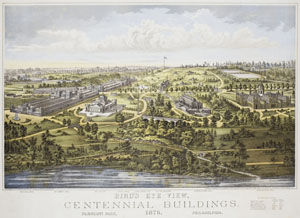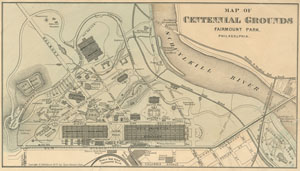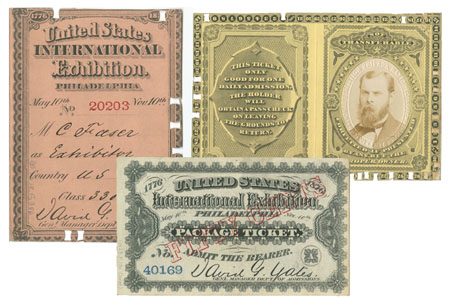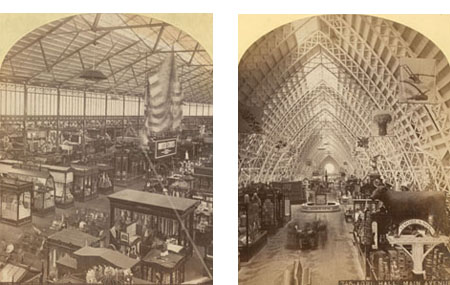OVERVIEW
In celebration of America’s one-hundredth anniversary of independence, the Centennial Exhibition took place on more than 285 acres of land in Philadelphia’s Fairmount Park May 10-November 10, 1876. Close to ten million visitors (9,910,966) went to the fair via railroad, steamboat, carriage, and on foot. Thirty-seven nations participated in the event, officially named the International Exhibition of Arts, Manufactures, and Products of the Soil and Mine. The grounds contained five major buildings: the Main Exhibition Building, Memorial Hall (Art Gallery), Machinery Hall, Agricultural Hall, and Horticultural Hall. In addition to these buildings, approximately 250 smaller structures were constructed by states, countries, companies, and other Centennial bureaus that focused on particular displays or services.
H.J. Toudy & Co., Bird’s Eye View, Centennial Buildings, lithograph, Philadelphia: 1875.
Thomas Hunter, Map of Centennial Grounds, Fairmount Park, Philadelphia, hand-colored lithograph, Philadelphia: 1876.
Admission to the fair was fifty cents for the general public, but exhibitors received free entry. Once admitted, visitors had to navigate the overwhelming spaces (the Main Exhibition Building, for example, stretched 1,880 feet in length) and the sheer number of displays (more than 30,000 businesses exhibited). They could use published catalogs that listed the classifications of products (e.g. Silk and Silk Fabrics) along with the building in which they were displayed, and in varying detail the location of an exhibitor within the building.
Samples of Centennial Exhibition admission tickets.
The Centennial Exhibition reflected a growing consumer and leisure culture of the mid-late 19th century. Never before had consumers been able to view so many practical and luxurious commodities from so many countries in one place. Manufacturers, dealers, and exhibitors of tens of thousands of products competed for the attention of prospective buyers by handing out printed circulars, trade cards, catalogs, and other advertising ephemera. The surviving documents generated by the exhibitors provide a sense of the extensive scope, size, and impact of the event.
Above left: Centennial Photographic Company, Main Building, from East Gallery, albumen stereograph (detail), Philadelphia: 1876.
Above right: Centennial Photographic Company, Agricultural Hall, Main Avenue, albumen stereograph (detail), Philadelphia: 1876.





